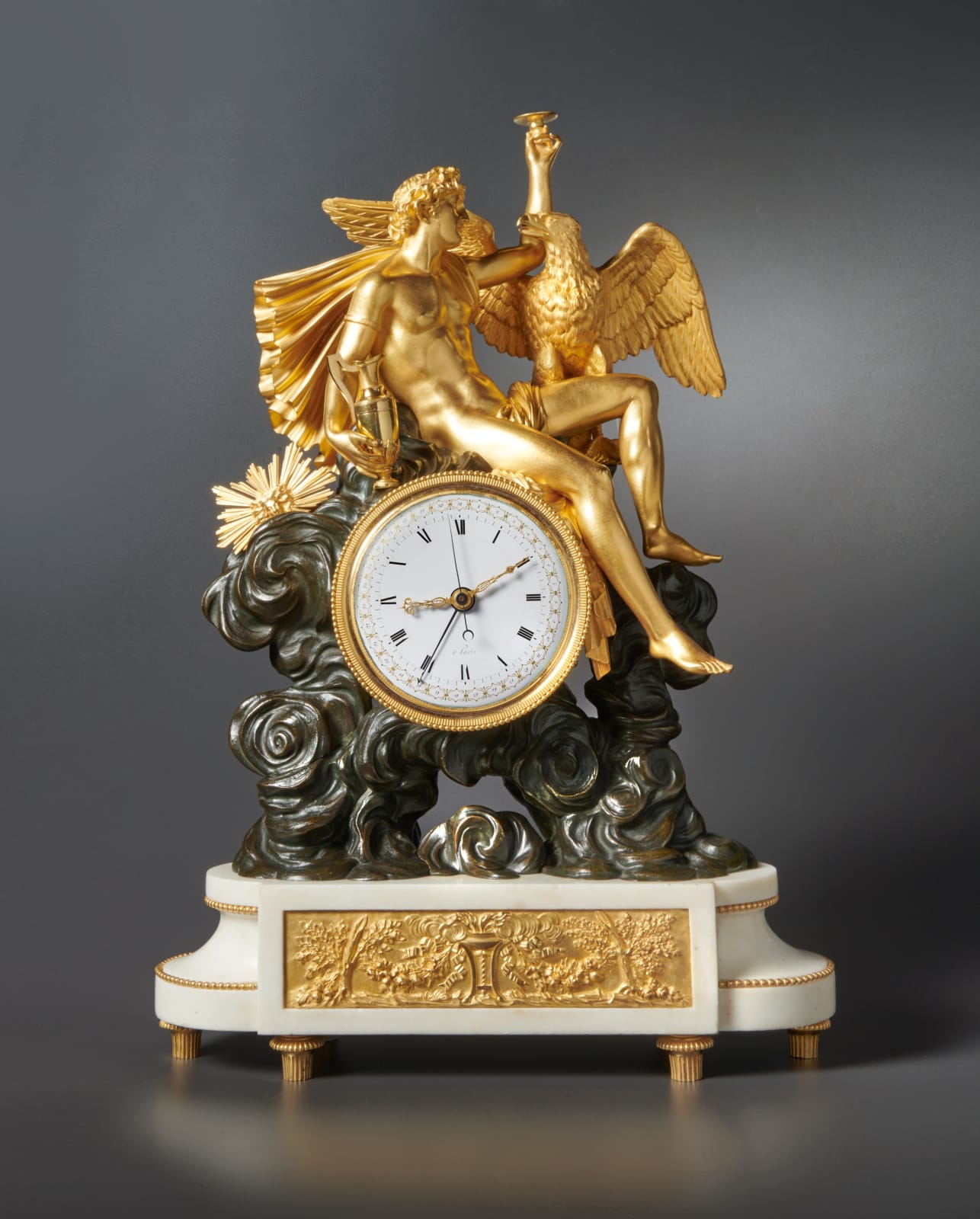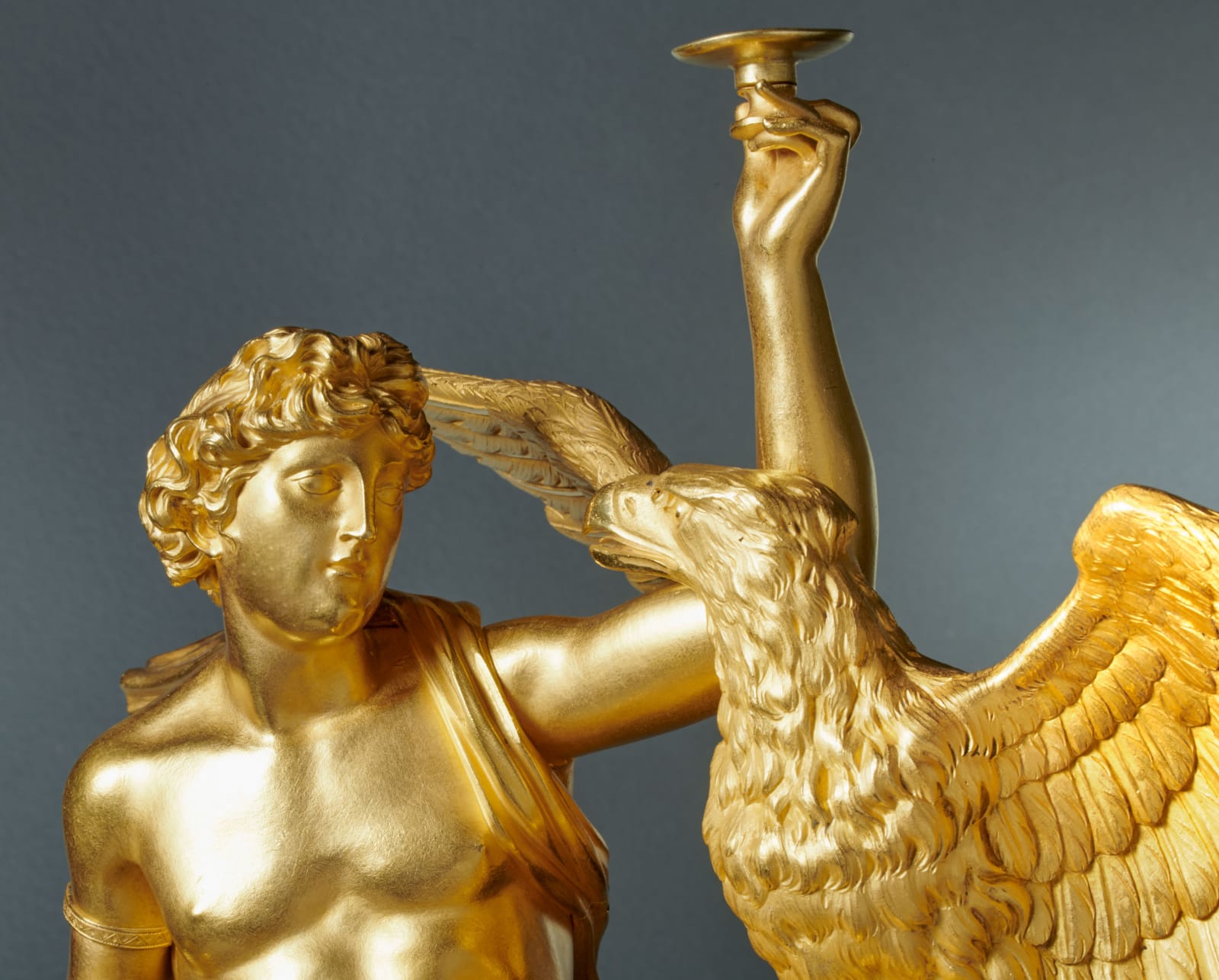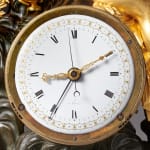Jean-Simon Deverberie 1764-1824
Further images
Literature
Hans Ottomeyer and Peter Pröschel, “Vergoldete Bronzen”, 1986, p. 380, pl. 5.15.24, illustrating a design by Jean-Simon Deverberie for this clock, in the Bibliothèque Doucet, Paris.
Charlotte Vignon, “Deverberie & Cie: Drawings, Models, and Works in Bronze”, in “Cleveland Studies in the History of Art”, vol. 8, 2003, p. 174, pl. 1.25, illustrating a coloured wash engraving of the same clock model featured in a Deverberie & Company sales catalogue of circa 1800, in the Bibliothèque Institut National d’Histoire de l’Art, Paris.
A rare and important Directoire gilt and patinated bronze and white marble mantel clock of fourteen day duration, the case by Jean-Simon Deverberie and the polychrome painted white enamel dial by Henri-François Dubuisson, signed Dubuisson below 6 o’clock. The beautiful dial signed à Paris, with inner Roman hour numerals and indications for the minutes and seconds and outer calendar ring marked 1-31, with each numeral within a gilded cartouche, interspersed by foliage and green beads, with a very fine pair of pierced gilt brass hands for the hours and minutes, a blued steel hand for the calendar indications and a blued steel pointer for the sweep centre seconds. The dial with the rare feature of having no winding holes, which instead are placed around the edge of the dial at just past 4 o’clock and at 8 o’clock, with a further winding hole above 12 o’clock for the fine adjustment, the winding holes are hidden behind the bezel which can easily be removed when needed. The movement with extra gearing to enable the winding holes to be outside the dial, with silk thread suspension, pinwheel escapement, striking on the hour and half hour with outside count wheel. The magnificent case featuring the figure of Ganymede nude except for drapery that wraps around his loins and around his shoulder, seated on billowing clouds that surround the clock dial. In his right hand he holds a pitcher and in his raised left hand he holds a cup. Beside him is Jupiter in the guise of an eagle whose outstretched wings seemingly embrace the youthful Ganymede. Peeping up behind the clouds to the left is a gilt sun and, on the reverse, a fretted door to enable the bell strike to be heard more clearly. The whole on a stepped white marble base with rounded ends and mounted on the front by a rectangular gilt bronze frieze centred by a flaming torchère flanked by fruiting and floral swags hung from trees at either end, on toupie feet
Paris, date circa 1800
Height 63 cm, width 43 cm, depth 14.5 cm.
This magnificent clock owes its beauty as much to the sumptuous case which was designed and made by Jean-Simon Deverberie (1764-1824) as to the exquisitely painted dial which was executed by Henri-François Dubuisson (sometimes referred to as Etienne Gobin; b. circa 1731 d. circa 1823). Its subject, which is rare amongst clock models, represents the story of Ganymede and Jupiter. Ganymede was a shepherd and son of Tros, a legendry king of Troy whose outstanding beauty caused Jupiter, the supreme ruler of the gods, to fall in love with him. According to Ovid’s Metamorphoses, Jupiter transformed himself into an eagle and carried the youthful shepherd to Olympus where he made him his cup-bearer in place of Hebe who until then carried out this role. The myth, which Homer recounts in a slightly different way, found favour in ancient Greece since it appeared to provide religious sanction for homosexual love. Ganymede was often depicted in later antique vase paintings and sculpture wearing a cloak, as indicated here by the swirling drapery. The subject was portrayed by a number of the great masters such as Michelangelo, who emphasised its homosexual aspect in his drawing of the subject (c.1533; Fogg Art Museum, Cambridge Mass) as too did Antonio da Correggio in his oil painting (c. 1530-32, Kunsthistorisches Museum, Vienna).
The case was designed and made by Jean-Simon Deverberie, featuring in one of his firm’s sale catalogues from 1800. Although the exact date when Deverberie became a maître bronzier is unrecorded, we know that he was working as a caster in 1788. Charlotte Vignon’s article (ibid) notes that he may have been the same Deverberie who specialised as a watchcase maker and that after the abolition of the guilds in 1791, he opened a bronze casting and clock factory with Jean George Hertzog. Having been established at rue Barbet au Marais, Deverberie then moved to rue des Fossés du Temple where he ran the firm of Deverberie et Cie. The lifting of the guild regulations during the French Revolution allowed casters, who were strictly limited to working in bronze during the ancient règime, to at last develop factories of their own. Deverberie was one such man who took advantage of this freedom so that now all stages of the bronze making process, from casting, gilding, assembly and retail could occur in one workshop. In this he proved highly successful since by 1803 his business was worth 104,000 francs and the previous year had sent goods worth 40,000 francs to the Leipzig fair.
Deverberie et Cie made a range of luxury bronze objects from chenets and fire grates to candelabra and chandeliers. However, clock cases were his speciality. Not all were fitted with his movements but included those supplied by the Imperial clockmakers Henri Lepaute and Lépine as well as Lemoine, Marc Sandoz, Dubuc (Dubucq) and others. At times Deverberie contracted part of the gilding to Jean Claude Herouard, Jean-Jacques Dubois and others and also bought in glass globe covers for his clock cases from the famous glass blower Jean-Baptiste Binet as well as marble from Gilles l’ainé. Unlike most major bronziers, Deverberie did not supply the Garde-Meuble direct though he may have done so through as intermediary. Rather he tended to cater for a private clientele; he also sold his cases to other European clockmakers while others were destined for the Russian and Turkish export market.
The clock was obviously destined for an important figure, especially as it features a beautiful dial by Dubuisson, who with Joseph Coteau was the leading enamellist of his day. Born in Lunéville, Dubuisson worked firstly as a porcelain painter in his hometown as well as in Strasbourg and Chantilly. Like Coteau, he was employed at Sèvres, where from 1756-9 he worked as a flower painter before specializing on his own account by supplying the finest enamelled watchcases and clock dials to the leading clockmakers of his day. Many were supplied to Robert Robin, who still owed Dubuisson 725 francs on his death (as did the bronzier Claude Galle who on his death in 1815 owed Dubuisson 120 francs). In addition to them Dubuisson worked for other celebrated makers including Dieudonné Kinable, Jean-Simon Bourdier, Louis Berthoud, Pierre-Basile Lepaute and Antide Janvier. Received as a maître on July 16th, 1769, Dubuisson was recorded in the rue du Roule by 1772, rue de la Huchette by 1795, rue de la Barillerie in 1799 and then in 1812 in rue de la Calandre.







